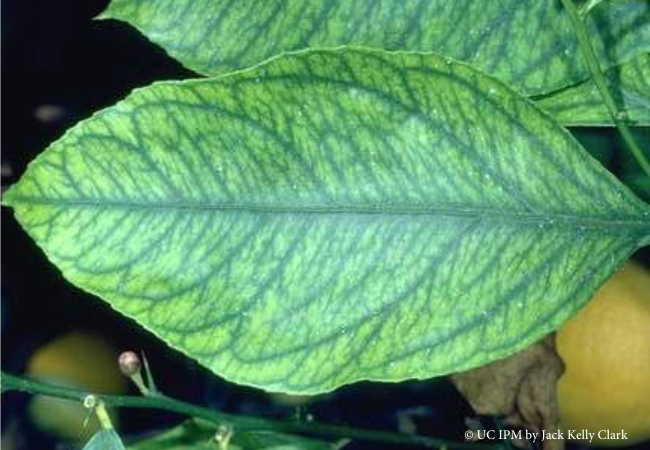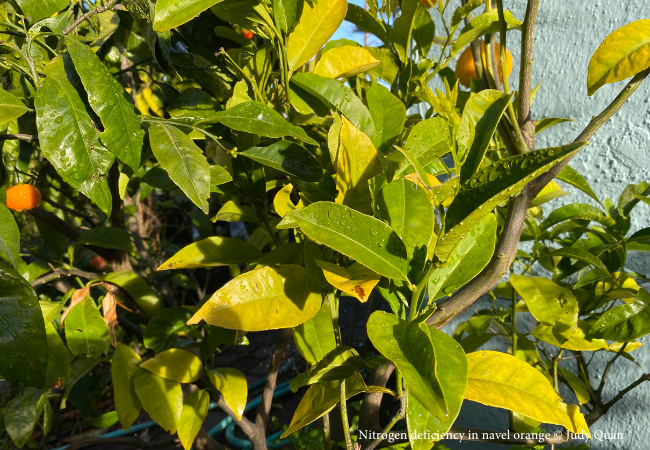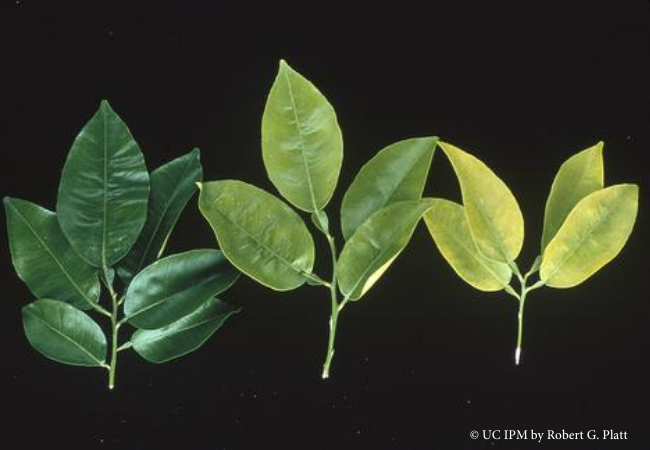In winter it's a normal process to see yellowing leaves and leaf drop. When we see this in other seasons, it indicates a problem. When we see the yellowing leaves on our citrus, we often jump to the conclusion there is an iron or a nitrogen deficiency, but there can be a variety of causes.
Before adding nutrients such as iron or nitrogen, consider things such as the time of year, watering practices, soil pH, general care practices, as well as the pattern of yellowing on the leaves.
Things to check first before adding nutrients:
√ Is it winter with cold soil temperatures?
√ Are rains or irrigation practices causing soil to be waterlogged?
√ Is soil pH alkaline, greater than 7.5?
√ What fertilizers have been applied?
√ What is the pattern of yellowing on the leaves, symptoms in older or younger leaves?
Certain conditions often make nutrients unavailable to plants, even though the nutrient may be present in the soil.
Alkaline soil pH. Soil pH is a measure of soil acidity/alkalinity, with 7.0 as the neutral point. Citrus, like other plants that are adapted to slightly acidic soil, are especially prone to iron deficiency when soil pH is above about 7.5 (alkaline). Alkaline soils hold onto iron, making it inaccessible to plants, even though typically iron is plentiful in most California soils. A pH of around 6.5 is ideal for citrus, but it can tolerate a range from 6.0 to 7.5. Adjusting soil pH needs to be done carefully and slowly to avoid unwanted effects in the garden.
Cold soil and soggy soil limit microbial activity important in getting nutrients to the plants. Microbes need porous soil and a certain temperature range to thrive, which is why chlorosis (yellowing leaves) is more common in winter. Porous soils have spaces in the soil that allow water and air to move easily in the soil. Compacted or clay soils are especially prone to a lack of porosity in cold, wet weather which may persist into spring.
Nutrient imbalances, especially an overabundance of zinc, copper, and manganese, can make iron less available. Causes vary, but imbalances can be due to over-application of certain fertilizers.
Identification: Iron deficiency symptoms: yellow leaves, green veins – primarily in young leaves. Nutritional deficiencies in citrus can be identified by the pattern of leaf yellowing and by noting whether it occurs on old or new foliage. The pattern of yellowing leaves between the small, darker green veins occurs primarily in young leaves. This happens as soils cool, reducing root activity. Other possible causes of that pattern of yellowing include zinc and manganese deficiencies. See the UC Integrated Pest Management website for pictures of various patterns of chlorosis.
What to do about iron deficiency?
Improve cultural practices and the soil environment.
- Make sure to irrigate with sufficient time between waterings to allow soil to dry but still provide enough water. Deep watering once a month is often sufficient, especially in summer.
- Make sure drainage allows roots to have air and water, avoiding waterlogged soil.
- Regularly add compost on top of roots, away from the crown of citrus. The addition of organic matter helps with iron deficiency as the organic matter decays and soil gradually becomes more acidic.
- If there has been a history of regular application of fertilizers, a soil test may be helpful to determine potential nutrient imbalances before applying more fertilizer.
- Iron, manganese and/or zinc deficiencies can be corrected with a foliar (leaf) application of a liquid micronutrient solution as the new growth emerges in the spring. You can also apply micronutrients, such as zinc sulfate or iron sulfate, to the soil. Microelements such as iron and zinc though, need an actively growing root system for uptake. Their soil application should be limited to the summertime.
Identification: Nitrogen (N) deficiency symptoms- leaves pale all over (light green or yellow), especially in older leaves. Nitrogen deficiency starts with older leaves near the bottom of the tree and foliage turns a uniform yellow. Slow growth and uniform yellowing of older leaves are usually the first symptoms of nitrogen deficiency. The causes include a true deficiency of nitrogen, adverse soil conditions, or unhealthy roots.
What to do about nitrogen deficiency in citrus?
Most citrus require regular fertilization with nitrogen. However, there are still conditions that would mimic nitrogen deficiency that would not be fixed by adding nitrogen.
- Wait until the soil is warmer, moist but not soggy, to apply nitrogen. Cold and soggy soil inhibits nitrogen uptake.
- Make sure to water with sufficient time between waterings to allow soil to drain well but still provide enough water to citrus. Deep watering once a month is often sufficient, especially in summer.
- Make sure drainage allows roots to have air and water, avoiding waterlogged soil, which often leads to rot and crown damage.
- Regularly add compost on top of roots, away from the crown of citrus. The addition of organic matter helps with iron deficiency as the organic matter decays and soil gradually becomes more acidic.
- Consider doing a soil test, either from a commercial laboratory or a home soil test kit. If there has been a history of regular application of fertilizers, a soil test may be helpful to determine potential nutrient imbalances and to know the current levels of nutrients such as N,P, K and pH.
- Remember it is possible to over-fertilize, potentially causing problems such as a delay in maturity and a reduction in fruit quality; so when in doubt, fertilize less.
When should citrus be fertilized?
Most mature citrus require regular fertilization with nitrogen.
- Begin nitrogen fertilization in February or March depending on the temperature, when soils are warmer and drier, just before pre-bloom.
- Fertilize only in the spring and summer months.
- Choose more frequent/small applications of nitrogen that allow more efficient nitrogen uptake, so less fertilizer is required.
- Or choose the more convenient schedule of three nitrogen fertilizations to be in February, early May and June – Valentine's Day, Mother's Day, Father's Day, with a last application perhaps in early fall.
- Stop applying nitrogen fertilizer if citrus leaf miner severely damages new foliage growth in late summer.
- Aim to go into winter with adequate nitrogen stored in the plant, so when spring comes, the nutrients are already there ready for the blooming period.
- Avoid late-season fertilization
- It may affect fruit quality, delay fruit coloring and make the rind rough.
- It stimulates new growth and makes trees more susceptible to frost injury. Subtropical plants, including citrus, develop some resistance to cold damage by going through quiescence, a resting time of no or slow growth when cooler temperatures arrive. Quiescence is induced several weeks after 40-50°F temperatures arrive. But that quiescence can be changed to active growing by pruning or nitrogen fertilization in early winter, increasing the possibility of cold damage.
- Avoid adding too much nitrogen, which can damage plants and cause other problems associated with nitrogen excess. Follow the directions on the package. If in doubt, fertilize less.
What fertilizer should be used?
- Nitrogen is the chief nutrient required by citrus and should be applied each year. Fertilizers commonly contain nitrogen (N), phosphorus (P), and potassium (K), listed as NPK on the fertilizer label. Look for a fertilizer where the first number (nitrogen) is the highest of the three, e.g., 7-3-3; fertilizers formulated for citrus typically have higher nitrogen with lower levels of phosphorus and potassium. Avoid balanced fertilizers such those labeled 10-10-10. The relatively high concentrations of phosphorus and potassium are not needed since they are held in the soil much longer than nitrogen.
- Choose the type that best fits your needs. Nitrogen can be provided as organic matter, inorganic compounds, or commercial slow-release (e.g., suffer-or polymer-coated urea). Some fertilizers add nutrients only; other fertilizers are also amendments that indirectly affect plant growth by improving the physical properties of the soil. You can find more information about fertilizers and amendments from The San Luis Obispo Master Gardeners in their pdf handout.
When we see yellowing leaves in our citrus, we want a quick easy answer. But by taking a more comprehensive look at our citrus, the soil and the moisture levels in the soil, as well as the seasonal temperatures, we are more likely to correctly diagnose the problem and then effectively adjust factors that will result in healthier citrus trees. And fertilizing with the right amount of nutrients, mainly nitrogen, at the right time will promote the health and productivity of citrus while minimizing problems associated with overfertilization.
This blog post is brought to you by the Help Desk of the Master Gardeners of Alameda County. Subscribe to our blog!
Have a gardening question? We'll help. You can reach us by:
- Emailing acmg@ucanr.edu. Please include a photo of the problem, if you can, plus your name, phone number, city and a description of the problem.
-
Using our online form.
-
By phone, during our office hours, 10 am to noon Wednesday and 11 am to 1 pm Thursday: 510-670-5645. At other times, please leave a message and we'll return your call during our office hours.
- In person at our Hayward office, during our office hours, only by appointment.
Resources
- Adjusting Soil pH in California Gardens, a free downloadable PDF
- A Guide to Citrus Nutritional Deficiency and Toxicity Identification
- Citrus for the Home Gardener 2008 Vincent Lazaneo, Horticulture Advisor
- Diseases and Disorders of Leaves and Twigs
- Fertilizing Citrus in the Foothills by Cindy Fake
- Iron deficiency UC IPM
- Nitrogen deficiency UC IPM
- When to Fertilize Avocado and Citrus in California


